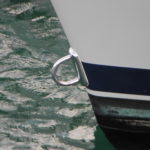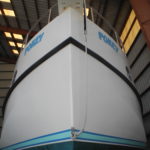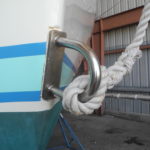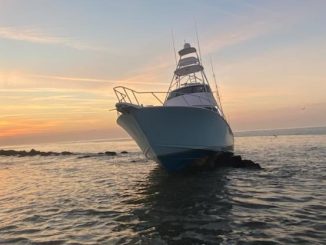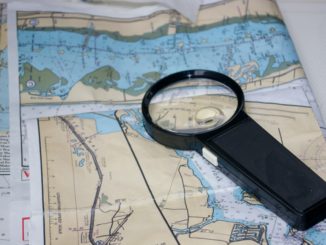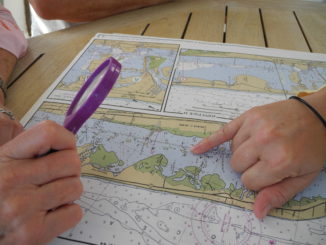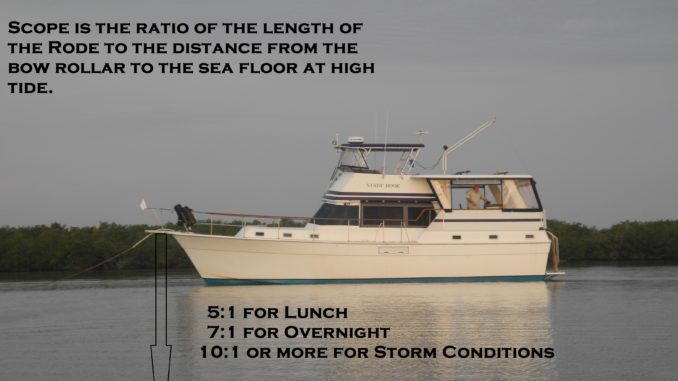
Ahhhh! To be at anchor in a peaceful cove…but you seem to be swinging – a bunch!
Let’s see… you have the right amount of rode let out and – uh-oh! The rudder is seriously turned to the port side so you keep hunting right and left, the bow in constant search for which direction to point.
First, try this.
Grab the steering wheel. Now turn. Turn. Turn. Turn. OK. Finally your rudder is in the middle. This can positively affect the unnecessary swinging you might have experienced.
You will see this is successfully accomplished if you have a rudder angle indicator or even an autopilot screen to verify that the rudder is in the middle. But if you don’t have either piece of equipment then try this trick. It’s an oldie but a goodie when all your technology takes a nap. Turn the steering wheel hard to port then count the full 360 revolutions as you turn the wheel hard to starboard. Count 10 turns? Then come back five and you are smack in the middle. Count eight and a half? Then come back four full turns and one quarter turn. Easy peasy!
The Wind or the Tide
Remember if you are in a tidal area then your boat will swing with the movement of the tide. But, the wind will compete with the tide and whichever is stronger will win, sometimes pushing you in a complete 360 if you are anchored in one spot through an entire tide change. If the wind is stronger than the tide sometimes you are completely sideways to both which can make for an uncomfortable side-slapping all night on your hull. Reverse eddies on a river can act in much the same way. For these reasons you want to select your anchorage wisely, based on wind and current forecasts.
Alarming Situations
I know some of you want me to talk about anchor alarms but my personal feeling is this: an anchor alarm is telling you that you are already dragging. I prefer not to be wakened with an alarm screaming go! Go!! GO!!! So do a bit of practice anchoring in the daytime before your first overnight. This allows you to learn how to properly use your equipment. And, practice also lets you learn what your boat feels like in a normal anchoring situation. Therefore if you believe that the tide or weather may drastically change at some point over night then set your wake-up alarm. Set the alarm to wake you before the expected tide/weather change should occur. Then you will be awake and ready for it. See that your boat turned, your anchor reset and then go back to a peaceful night’s sleep.
Sometimes NOAA fibs a bit so we don’t like to get caught off guard. We try to leave a few tell-tales to let us know the weather is changing. A stronger wind will amplify the squeak of a rapidly waving burgee. This can wake those sleeping in a bow stateroom. But if you are insistent on relying on an electronic anchor alarm then be prepared. Be sure the power supply won’t be interrupted. Phone apps can drain your battery in a snap. Then, make certain that the sound of the alarm is easily heard in your stateroom.
Decrease the Radius
The best way to reduce your swing radius while at anchor is to have less rode deployed overboard. Keep in mind a few things when you deploy the typical 5, 7 or 10 scope. You calculate the scope with measurements from the anchor roller or point of attachment to the boat which is high on deck. If you have a boatyard install an “eye” near the waterline you can reduce the amount of rode used and therefore reduce the amount of swing. On our boat we could have reduced the scope by five feet had we installed the lower eye.
Many high bow Trawlers have an eye installed for this very reason. Look at the Nordhavn, Krogen, Great Harbor and Grand Alaskan and you will see a stainless steel eye down near the waterline on the bow. This is not used to pull the boat onto a trailer (sorry, had to say that). Attach a snubber to the eye and use a chain grabber to attach to the anchor chain itself. Easier than you may think. See photos below to get the idea. We detail the concept in our Anchoring video.
ABCs of Anchoring
If you are just starting out, don’t worry. We all were beginners at one time or another. The more you learn, then more fun anchoring can be. Click here to check out our 90 minute Anchoring video. Join us at a Cruising 101 FUNdamentals seminar and discover anchoring, navigation, trip planning and so much more. Ask Captain Chris! 772-205-1859

